You know the drill. Go on hiatus because life is busy, catch COVID again even tho I wear a mask, and uncover yet another browser bug while still somewhat sick (getting better tho!).
The bug I have for you today is very special to me. We’ve been encountering it on-and-off at Roam for a while now, since January I think? Customers would report “hey something happened and now my entire screen is shifted up”, and we would say “can we see?”, and they would send screenshots showing sure enough, their entire screen was shifted up. It even happened to me once, though it was less dramatic a shift than some:
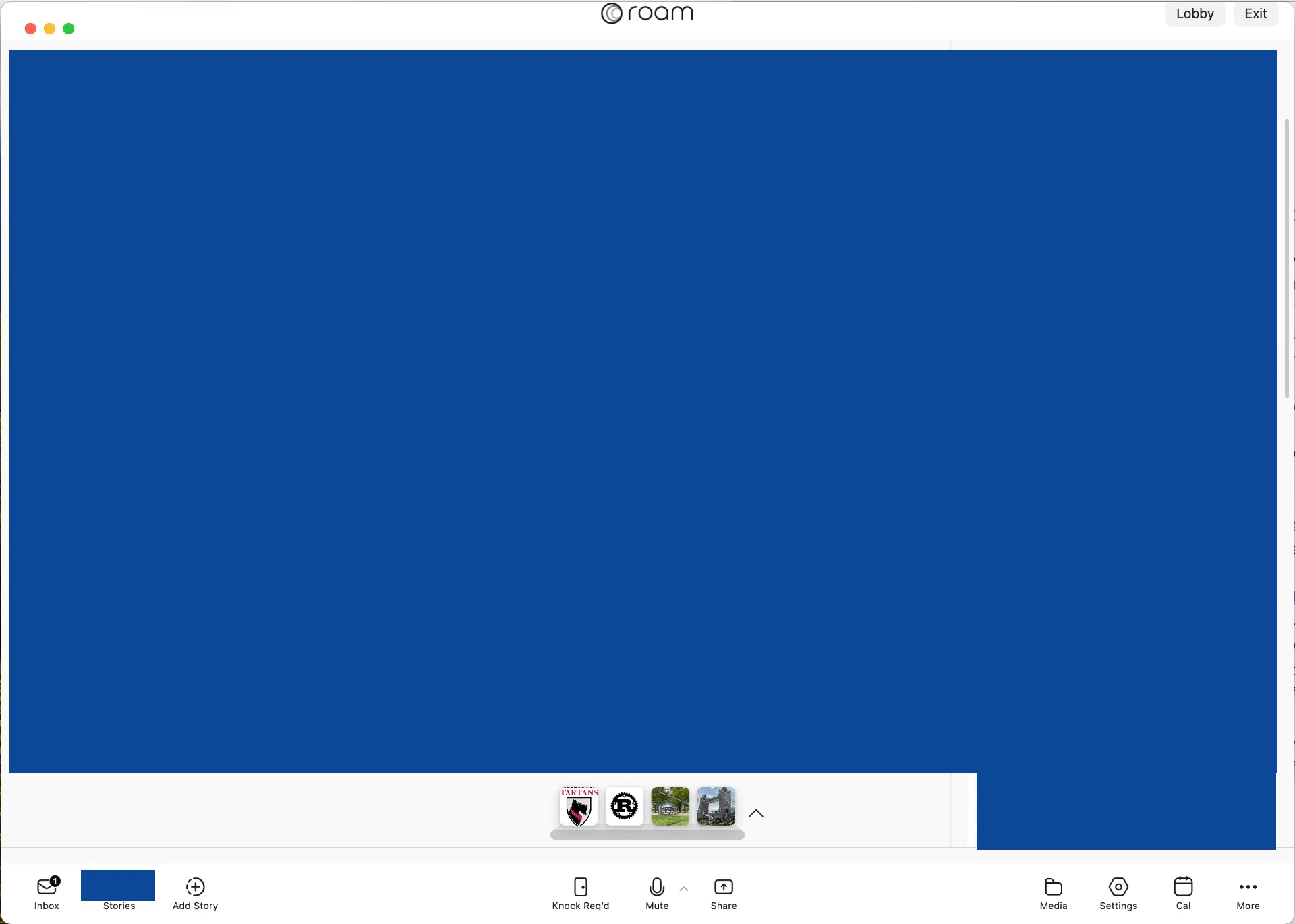
Invariably, the reproduction (“someone sends me a chat message while I have Roam open on my external monitor”, “it happens when my computer wakes up from sleep”) wouldn’t work every time for them, and would never work on our computers, so we’d be stumped, and that would be the end of it. It drove me crazy. Not having access to a consistent reproduction meant I was up a creek with no way to solve it.
Once, months later mind you, we got lucky that one customer was willing to screenshare during their bug encounter, and I got to poke around second-hand in devtools. What I found was, uh,
The Entire <body> Element Was Shifted Up
Well that’s just impossible! Ok well clearly it is possible, given we’re seeing it live, but our mess of like 10 container divs shouldn’t leave any room for the body to scroll at all. And it’s not the <body> that’s scrolling, it’s something else entirely!
Looking at the situation more, I wasn’t entirely convinced that our mess of 10 container divs always behaved correctly. So I rolled up my sleeves and worked to reduce that number to 3 container divs. Everything worked fine, and to top it off, we got no more reports from them or any other customer about their screen shifting! The end :) What a happy tale about reducing technical debt paying off :)
Except, that’s not the end. That can’t be the end. No way did I witness something impossible, that only happens in extremely specific circumstances, only on customer machines, for it to be our fault. My nose is attuned to the smell of browser bugs, and oh brother does it stink.
Shifting 2 - Electric Boogaloo
There’s a longstanding issue with the drag-n-drop library we use, @hello-pangea/dnd, not working in any Electron window besides the main window. So, my coworker Klas Leino recently put in a herculean amout of effort to switch us over to dnd-kit. Natually, changing drag-n-drop libraries involves lots of reshuffling of divs, with no guarantee that behavior is unaffected. So we did what we normally do: feature-flag it for internal use only, and test it by dog-fooding our own software daily.
And it’s a good thing we do this too, because sure enough our bug-testing processes caught a bug: another coworker, Theo Ouzhinski, noticed that whenever he clicked an unread message on his external monitor, his screen would shift up.
HM THAT SOUNDS FAMILIAR
It was a bit different than before, though. Instead of the entire <body> being shifted, it was just the part inside the floating inbox. And instead of being finicky to trigger, it was very reliable: get a new unread message, click on it, boom. And, the most crucial part of all, it reproduced on my machine:
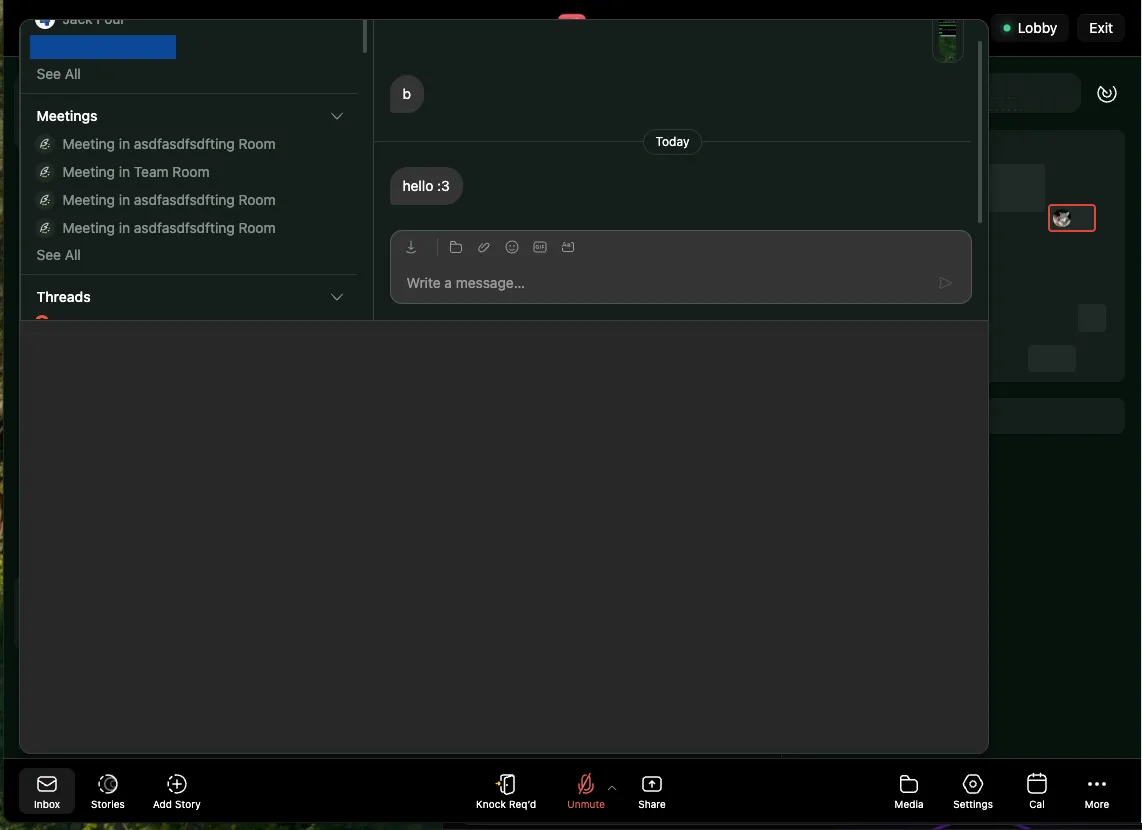
Debugging Time ^w^
The next few hours were a flurry of hypotheses and seeing where it reproduced and where it didn’t. In the end, I was left with some required conditions for the bug to reproduce in our app:
- Reproduces across platforms (Mac, Windows), on many different types of displays
- Depends on the display; e.x. on my Mac’s built-in display, it won’t trigger, but on an external display plugged into the same Mac, it will.
- Reproduces only in Chrome/Electron, not Safari or Firefox
- Must click an unread channel; normal navigation is unaffected.
A CSS Footgun?
After more digging & some wild hunches, I found out what was actually going on: there was an outer container with overflow: hidden and a scrollHeight greater than its own height. When an unread channel is clicked, we load in the messages, then call element.scrollIntoView() on the earliest unread (incidentally, this is why it only happened for unread messages; normal navigation didn’t make this call). When that earliest unread is “the latest message”, this can cause all containers with room to scroll to scroll to their bottoms, including the overflow: hidden one. I did not expect this since the overflow: hidden container should not have scroll on it.
Initially, I thought it was impossible for overflow: hidden elements to scroll at all. However, both MDN and this codepen I wrote falsify that hypothesis; elements with overflow: hidden can have a larger scrollHeight and are expected to be able to scroll.
<div class="outer" style="height: 400px; overflow: hidden;">
<div class="inner" style="height: 400px; overflow: hidden;">
<div class="content" style="height: 600px; position: relative;">
<span id="top">Top</span>
<span id="bottom" style="position: absolute; bottom: 0;">Bottom</span>
</div>
</div>
</div>With this structure, .inner will be the one to scroll when we call bottom.scrollIntoView(). And .outer will have a scrollHeight of 400, because .inner doesn’t overflow it at all.
A CSS Bug
But apparently, under some Sufficiently Complex CSS Conditions, .outer does have a scrollHeight much greater than .inner, even when both have overflow: hidden. Based on reading the spec, that’s a bug: outer.scrollHeight should not be larger than the box of its only descendant. With that in mind, I’d like to present my hand-minimized reproduction of these Sufficiently Complext CSS Conditions1, whose <div> ids I’ll be referencing in the coming explanation:
https://static.duvallj.pw/2024-11-19/scrollHeightBug/index.html
Source code:
<!doctype html>
<html>
<head>
<title>scrollHeight bug</title>
<style>
* {
box-sizing: border-box;
}
body {
min-height: 100vh;
text-rendering: optimizespeed;
margin: 0px;
}
#root {
background-color: white;
color: black;
}
#outer {
will-change: transform;
overflow: hidden;
}
#inner {
overflow: hidden;
}
#padding {
margin: 1px;
}
#scroll {
height: 600px;
position: relative;
overflow: auto;
}
#spacer {
position: relative;
height: 1500px;
background-color: lightblue;
}
#pixel {
position: fixed;
width: 1px;
height: 1px;
margin: -1px;
border: 0px;
padding: 0px;
overflow: hidden;
}
#output {
position: fixed;
bottom: 0;
right: 0;
}
</style>
</head>
<body>
<div id="root">
<div id="outer">
<div id="inner">
<div id="padding">
<div id="scroll">
<div id="spacer">
<span style="position: absolute; top: 0">Top</span>
<span style="position: absolute; bottom: 0">Bottom</span>
</div>
<div id="pixel"></div>
</div>
</div>
</div>
</div>
<div id="output"></div>
</div>
<script>
const recalc = () => {
const outer = document.getElementById("outer");
const inner = document.getElementById("inner");
const output = document.getElementById("output");
output.innerHTML = `
outer.scrollHeight=${outer.scrollHeight} outer.clientHeight=${outer.clientHeight}<br>
inner.scrollHeight=${inner.scrollHeight} inner.clientHeight=${inner.clientHeight}
`;
setTimeout(recalc, 1000);
};
setTimeout(recalc, 0);
</script>
</body>
</html>If the bug occurs, outer.scrollHeight will be 1502, not matching any of the other values displayed, which are all 602. Because I read the spec, I am confident in calling this a bug, even though both Chrome and Firefox seem to have the same behavior2:
| Chrome | Firefox | Safari |
|---|---|---|
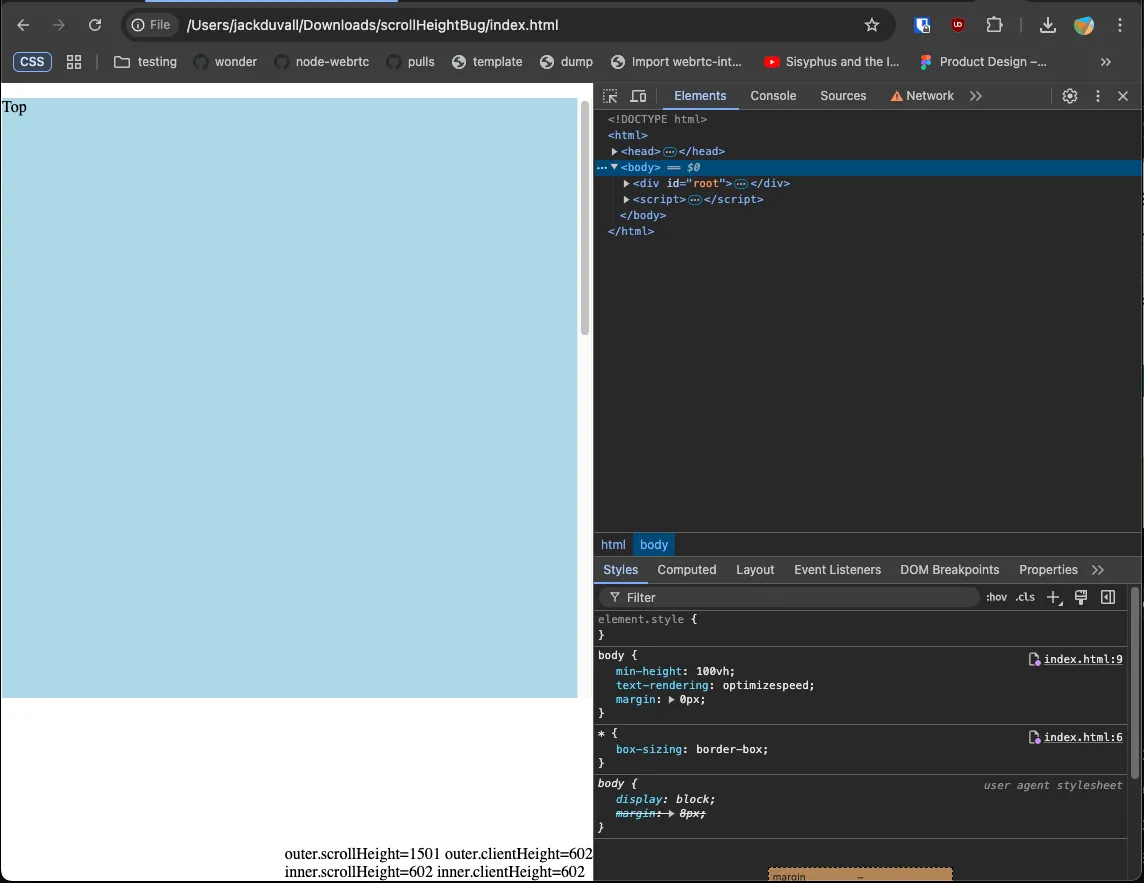 | 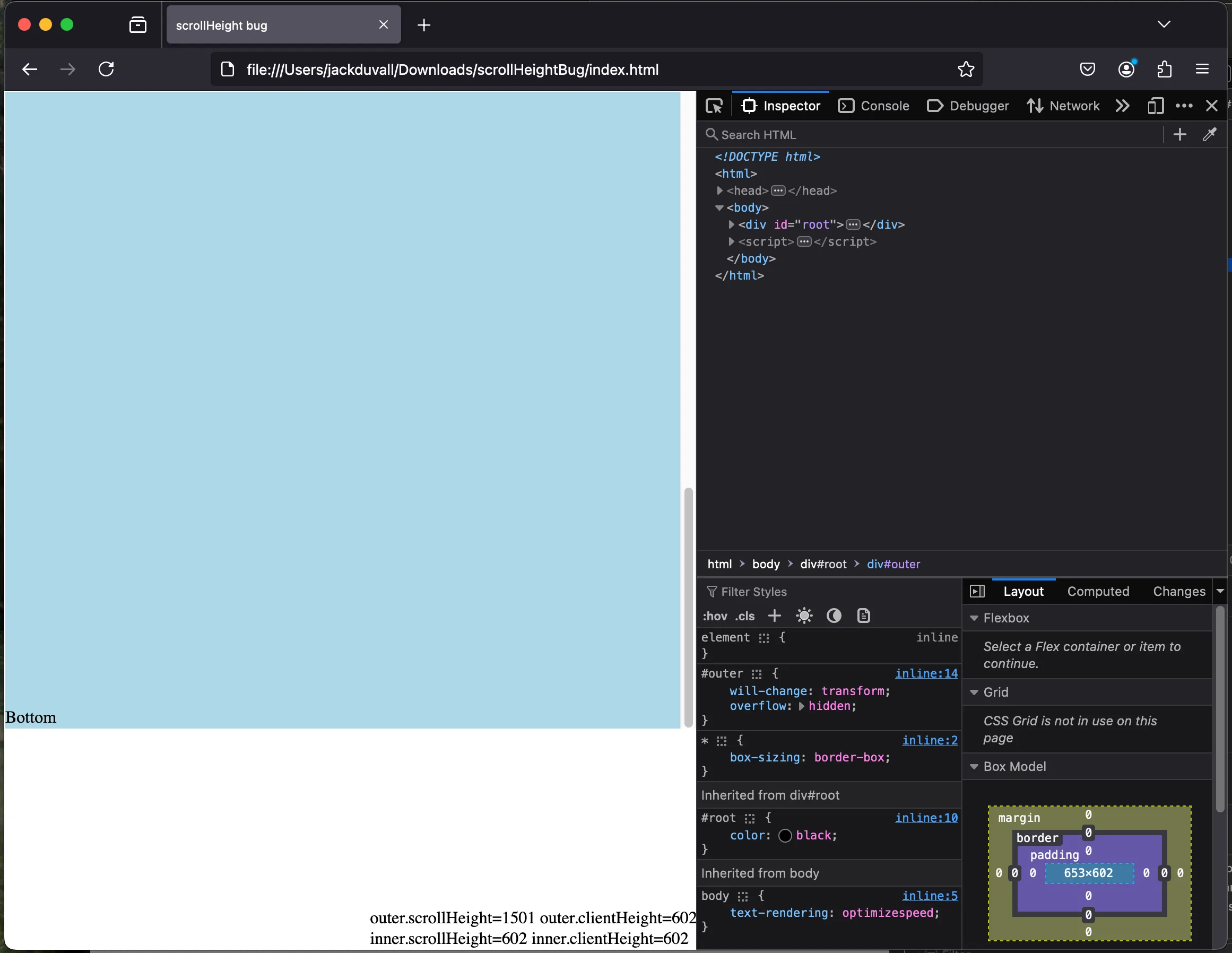 | 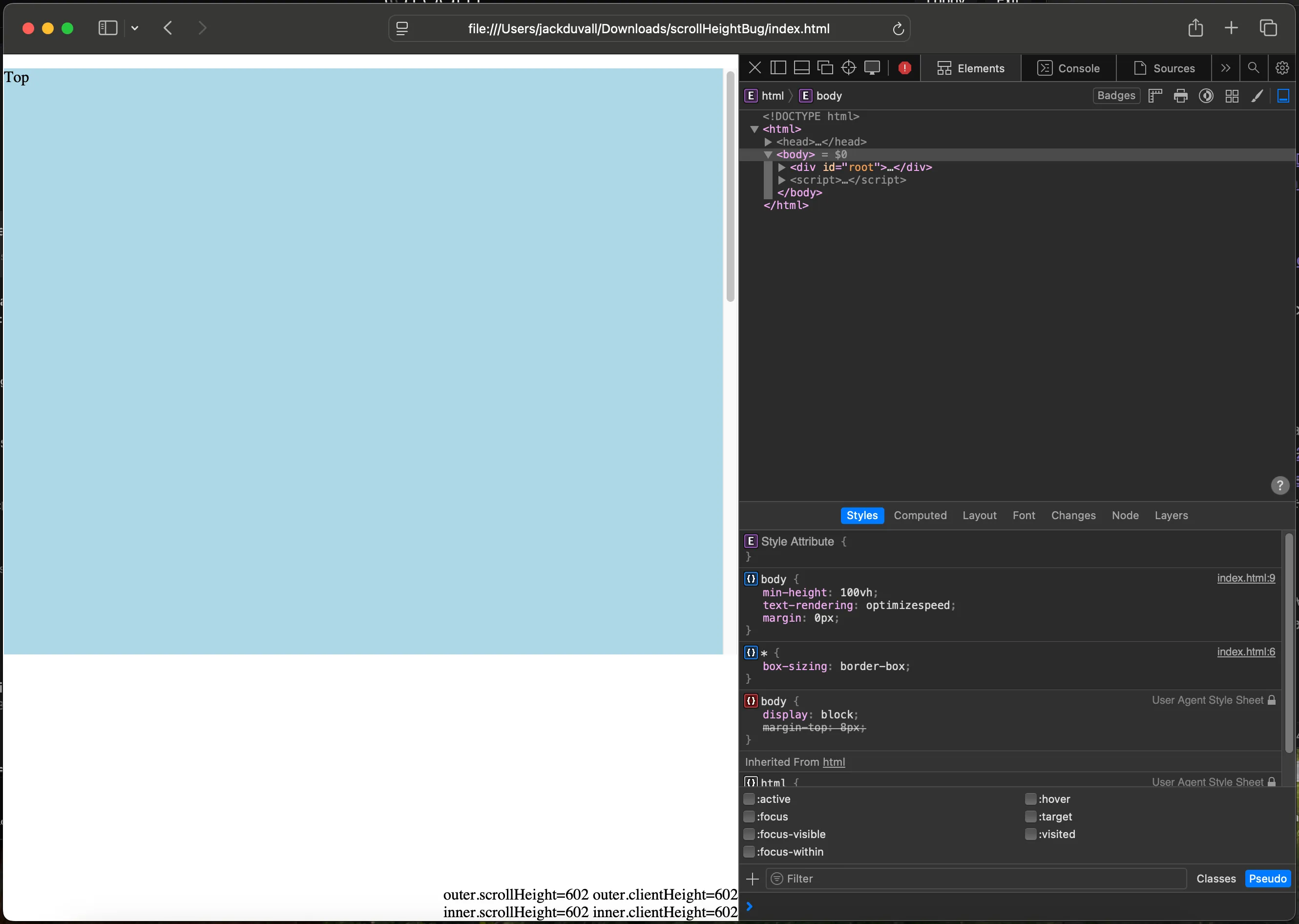 |
I am also very confident in calling it a bug because removing the will-change: transform; property from #outer causes the bug to go away on both Chrome and Firefox3. Additionally, on Chrome only, doing any of the following will also cause the bug to go away:
- Setting
left: 1px;on#pixel(it already had this as a computed value from the defaultleft: auto;) - Removing
margin: 1px;from#padding(??? in Firefox it doesn’t seem to matter if this div is present)
I highly encourage you to play around with this example in DevTools to get a feel for just how weird it is. That’s the thing with browser bugs: you thought you were standing atop a rock-solid platform, only to find out it’s made of crumbling sand.
Resolution
The best fix I’ve found for this bug is to just add top: 0; to #pixel. This works on both Chrome and Firefox, I think because setting an explicit top property moves the #pixel element firmly inside the container it’s supposed to be in, causing no more weird scrollHeight calculations to happen. I’ll patch dnd-kit locally, open a PR upstream, and send some P4 bug reports to Chrome and Firefox that will never get fixed. But hey, maybe I’ll be proven wrong! After all, this other bug I independently found eventually got fixed! In any case, just knowing enough about the bug to fix it w/o waiting for Chrome is a huge weight off my shoulders. Thanks for reading, until next time!
Footnotes
-
One unexpected benefit of making a minimal repro is that the bug no longer depends on what monitor you use, only what browser. Lucky, I guess! ↩
-
All of these screenshots are from my work MacBook, running MacOS 15.1 & the latest versions of every browser. The Chrome and FireFox examples repro on my Windows 11 laptop too. ↩
-
And I know it’s not an interaction with stacking contexts, because replacing that with
position: relative; z-index: 0;orwill-change: opacity;(which will also create stacking contexts) makes the bug go away. Something about thetransformoptimization path is making things go awry. ↩
